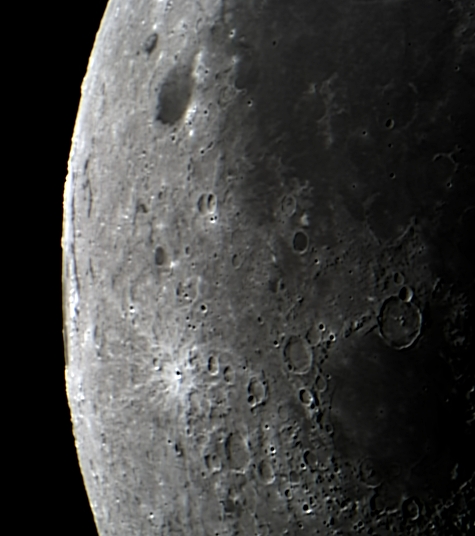
Mare Orientale is actually on the "far side" of the Moon. However, due to lunar libration, it can occasionally be glimpsed on the western limb of the lunar surface. This image shows Mare Orientale during the favorable lunar libration of September 20, 2003. Mare Orientale is a vast impact basin. It was caused by the last really big chunk of debris to hit the Moon. The rock that impacted the Moon is estimated to have been several tens of meters across. The inner lava-flooded section (appearing dark and relatively smooth) has a diameter of about 320 kilometers. The concentric rings around the basin are shock waves in the lunar crust that are , in effect, "frozen" in time. The diameter of the outer-most ring is about 930 kilometers. Under extremely favorable conditions of lunar libration, we can just glimpse the dark basalt lava floor of the basin nearly edge on.
Libration refers to the apparent rocking of the Moon as seen from Earth. It is caused in part by the fact that the Moon's orbit is not perfectly circular. Any object that orbits in an ellipse will move faster when it is near the planet or star about which it orbits, and slower when it is farther away. The Moon rotates on its axis at a constant rate. If the Moon's orbit was perfectly circular, the rotation of the Moon on its axis would exactly match the speed of the Moon as it orbits the Earth, and we would always see exactly the same face of the Moon. However, due to the non-circular orbit, the rotation rate gets ahead of the orbital speed when the Moon is farther away (and moving slower in its orbit); and the rotation rate gets a little behind when the Moon is closest (and moving faster in its orbit). Instead of seeing only 50% of the surface of the Moon, because of libration, over time we actually get to see about 59% of the surface.
H.P. Wilkins and Patrick Moore drew attention to the possibility of a far-side mare on the Moon in the 1940's. At that time, we referred to this limb of the Moon as the eastern limb, and thus they named it Mare Orientalis, meaning the "Eastern Sea." Later the IAU convention was adopted and this limb of the Moon is now considered to be west.
Move your cursor over the image, and pop-up windows will appear that identify various craters and other features on the Moon.
My image was taken with a ToUcam webcam. Individual frames from the video captured with the ToUcam were aligned and stacked using Registax. The image was taken from my backyard in Scottsdale, Arizona, with an FCT-150 scope carried on an NJP mount. A 4x PowerMate was used to lengthen the focal length of the scope to about f28.
September 20, 2003
Image by Sid Leach
Scottsdale, Arizona
Recent Images.
Complete list of images.
Description of equipment used to acquire images.
Home
Feedback and comments should go to Sid